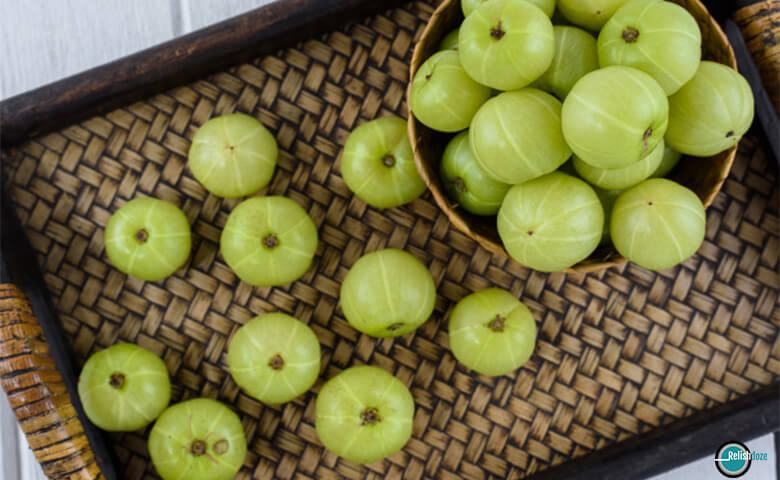Amla is an Indian fruit, a rich source of Vitamin C & antioxidants. Also known as Indian Gooseberry, Amla has been widely used in Ayurveda since ages. Now even modern medical science has proved its benefits by conducting various researches. In Ayurveda, mostly it has been used to improve quality of blood, bones, digestive system, liver and skin. It has coolant properties, which help in smoothening the Pita Dosha in human body.
Table of Contents
Health Benefits of Amla
Amla has multiple health benefits, here we have jotted down a few for your reference.
Prevention of Hyperlipidemia


It prevents high cholesterol level in the blood by curbing the oxidative stress in blood fat. So, it automatically prevents various diseases linked with heart. Most importantly and commonly it helps in the case of Atherosclerosis, which is hardening of blood vessels in heart due to accumulation of high blood fat content.
Prevention Of High Blood Pressure


It prevents development and progression of high blood pressure. It helps in normalizing blood pressure by certain antioxidants found in it, which reduces free radicals stress and hence reduces Oxidative stress.
Improves Skin Quality
As it has antioxidant properties, so it slows down the aging process, hence skin becomes more viable, living, and blemishes & wrinkles free.
Improves Vision, And Prevents certain Eye Disorders
It is helpful in managing number of eye disorders like
- Lacrimation (Tear Formation).
- Redness, burning sensation, itching of eye and improves eyesight.
- Tannins in Amla help to manage diabetic mellitus and prevents loss of vision by reducing fluid pressure in eye.
- It works as a natural eye tonic. Many Eye drops contain Amla juice due to its antimicrobial, antioxidant, anti-inflammatory properties.
Improves Quality of Hair
It’s antioxidant properties make it viable to give shine and improves blackness to hair. It reduces hairfall, hence improves thickness and length of hair, premature greying of hair and hair fall. It can be used as Amla Hair oil or Amla content in shampoo. You can also mix alma powder to curd and apply it as a mask for good results.
Reduces Joint Pain and Swelling
The antioxidants present in Amla, balances the Vata Dosha in body, hence it reduces inflammation, as a result relieves pain and swelling of the joints. Hence, it increases mobility of the patient.
Diabetes Mellitus Type 1 & Type 2
It helps in controlling blood sugar levels by regulating carbohydrate metabolism due to its astringent and rejuvenating properties. In the patient of DM, it reduces fasting and post prandial blood glucose level by regulating blood glucose metabolism.
Pancreatitis
Amla shows protective action by fighting against free radicals and reducing the number of inflammatory mediators. Hence, inflammation in pancreas reduces.
Improves Digestion and Relieves Constipation
It increases Pachak Agni means Digestive Fire, which means it increases the digestion power. It results into getting a person hungrier than before. Also, if taken in night with triphala powder and luke warm water, it relieves constipation.
Hepatoprotective Property
It prevents damage of the liver cells . Also lowers down the inflammatory mediators and liver enzymes. It controls obesity by improving the metabolism of the body.
Helps in Managing Neurological Disorders
Due to its anti-cholinesterase activity, it can be used in management of the following:
- Dementia
- Alzheimer’s disease
- Parkinson’s disease
It fights against free radicals and inhibits inflammatory mediators to reduce brain damage and improves cognitive functions.
Prevention Of Cancer
It increases activity of natural killers cells leading to toxicity and breakdown of cancerous cells. It inhibits growth of multiplication of cancer cells to some extent by inhibiting certain enzymes.
Side Effects of Amla
They say,” Excess of everything is bad”. So, if not taken in the prescribed quantity, Amla can also have some harmful effects. Here we have a few examples of such side effects:
- Triggers Hyper-acidity: As it contains high amount of Vitamin C, it is acidic in nature. It is mainly used for detoxification but it can trigger hyper-acidity too.
- Constipation: Although it is a natural remedy for constipation due to its high fiber content, but it can harden the stool if you consume it in high quantity. Make sure when you take Amla, adequate water should be taken along.
- Allergy: Some people can be allergic to Amla. People might experience an upset stomach, cramps, nausea, vomiting, redness, diarrhea, abdominal pain, swelling around mouth, obstructed breathing, itching, redness on the face, headache, and dizziness. If you see any of these symptoms, you must see a doctor immediately.
- Cold: It can increase risk of bleeding and bruising in people with already bleeding disorders. So, it is advisable to use it cautiously with these patients.
- Avoid using in aggravated Kaph Dosha in body , due to its coolant and astringent effect people might get sore throat and cough .
- High dosage of Amla can cause skin dryness.
- Avoid taking Amla juice in night due to its cooling property.
- Use it cautiously while breastfeeding.
- Due to its coolant properties, it lowers down the body temperature. So, consuming it, can aggravate the symptoms if one is already suffering from cold or any other related condition.
- In patients of DM type 1& 2 it reduces blood sugar level, so monitor it regularly if one is taking it along with anti- diabetic drugs.
Amla can be taken in various forms, as per your comfort you can consume it:
- Fresh or dried or frozen
- Amla Juice
- Powder
- Amla Candy
- Murabba
- Amla chutney
- Capsule
- Amla Tablet
Hope this information helps you in making the best use of Amla.

